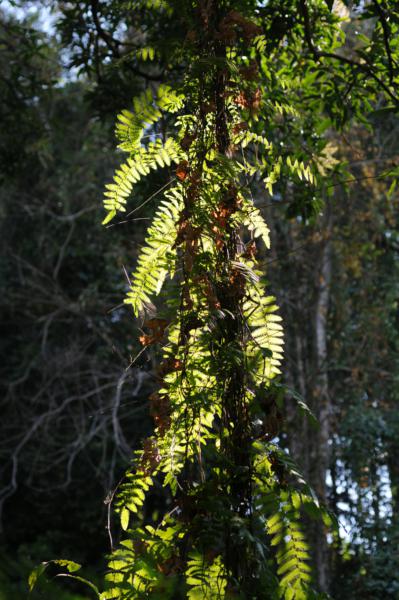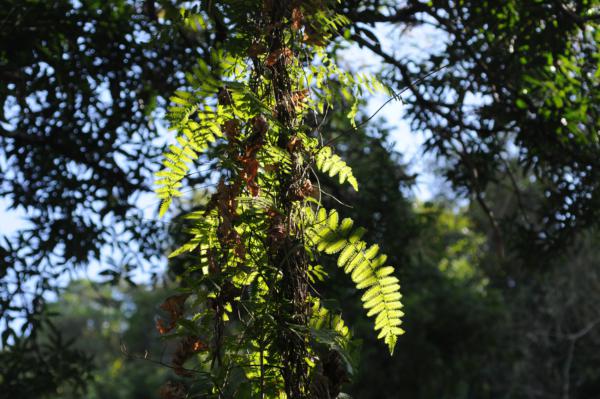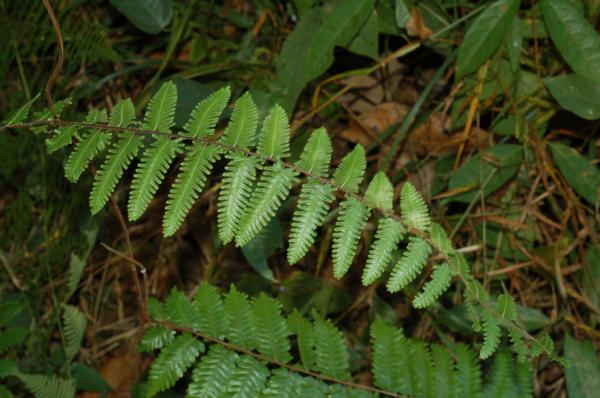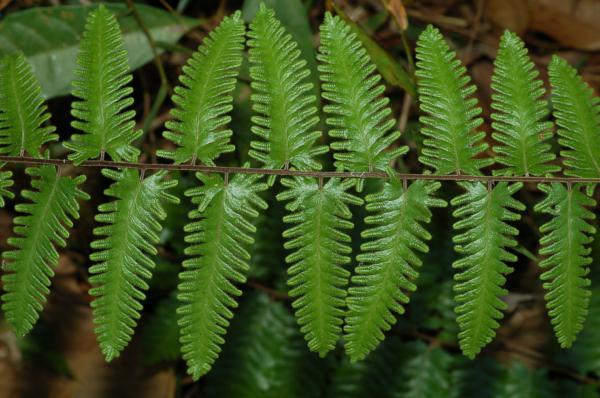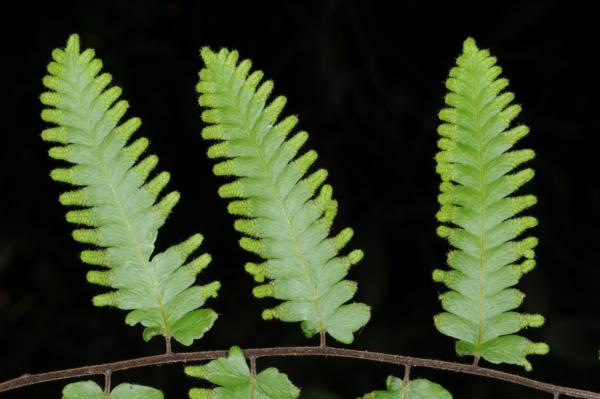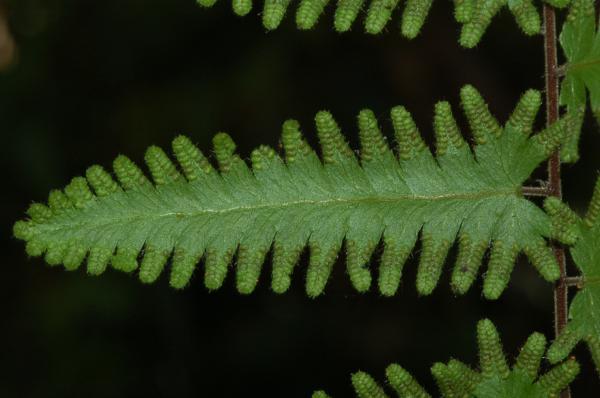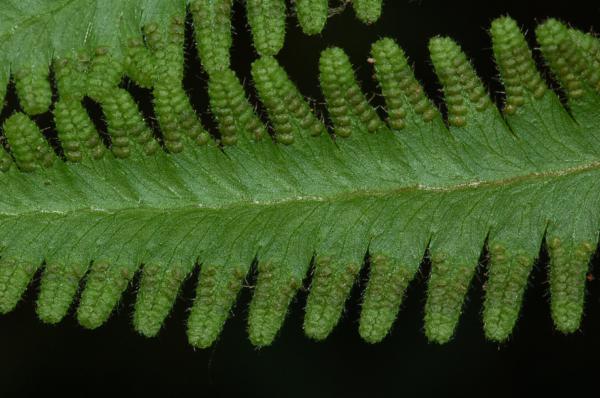
Lygodium polystachyum Wall. ex T.Moore
Family
Lygodiaceae
Nomenclature
Lygodium polystachyum Wall. ex T.Moore, Gard. Chron. 1859: 671. 1859; Bedd., Handb. Ferns Brit. India: 458, f. 284. 1883; Bonap., Notes Ptérid. 14: 70. 1923; E.Smith, J. Siam Soc. Nat: Hist. Suppl. 8: 8. 1929; C.Chr., Contr. U.S. Natl. Herb. 26: 329. 1931; Tardieu & C.Chr., Fl. Indo-Chine 7(2): 40. 1939; Holttum, Rev. Fl. Malaya ed. 1, 2: 56, f. 10. 1955 [‘1954’]; Holttum, Fl. Males., Ser. II, Pterid. 1: 46, f. 5c & 8a–c. 1959; Holttum, Dansk Bot. Ark. 20: 16. 1961; Ching, Fl. Reipubl. Popularis Sin. 2: 110. 1959; Tagawa & K.Iwats., SouthE. Asian Stud. 3(3): 72. 1965; Tagawa & K.Iwats., SouthE. Asian Stud. 5: 34. 1967; Tagawa & K.Iwats., Fl. Thailand 3: 59. 1979; Boonkerd & Pollawatn, Pterid. Thailand: 34, 83. 2000; Newman et al., Checkl. Vasc. Pl. Lao PDR: 28. 2007.
Description
Rhizome shortly creeping, densely covered with black hairs. Fronds climbing, sometimes more than 3 m tall; stipes 25–40 cm long, brown, densely hairy throughout, up to 4 mm diam., terete, wingless; hairs on stipes as well as on rachis setose, stiff, patent, multicellular, brown or paler, up to 2 mm long; rachis like the upper part of stipes, slender, paler, hairs less dense and short, terete; pinnae numerous, 10–20 cm apart; primary rachis-branches very short, usually 2–3 mm, the apex densely covered with brown hairs, dormant but occasionally a little protruding in the lower pinnae; secondary rachis-branches 20–30 cm long, densely hairy with short unicellular hairs, wingless; leaflets 10 or more in pairs on secondary branches, with short stalks of 2 mm or so, oblong-subdeltoid, acute to moderately so at apex, subtruncate at base, indistinctly articulated at the junction of stalk and laminar part, pinnately lobed to half way, hairy on veins and margin, at most 7 cm long and 2.5 cm wide at basal widest portion; ultimate lobes round at apex, entire. Sporangia-bearing lobes narrow, 1.5–2 mm wide, 3–7 mm long; indusia densely covered with long pale hairs.
Distribution in Thailand
NORTHERN: Chiang Mai, Chiang Rai, Lampang, Phitsanulok; NORTH-EASTERN: Phetchabun; SOUTH-WESTERN; Prachuap Khiri Khan; CENTRAL: Nakhon Nayok; SOUTH-EASTERN: Chon Buri, Trat; PENINSULAR: Chumphon, Surat Thani, Phangnga, Krabi, Nakhon Si Thammarat, Phuket, Trang, Songkhla, Yala, Narathiwat.
Distribution in Laos
Luang Phrabang, Savannakhet, Sayabouly, Vientiane.
Distribution in Cambodia
Ratanakiri.
Wider Distribution
India (Assam), Burma, SW China (Guangxi & Yunnan), Indochina and Peninsular Malaysia.
Ecology
Climbing, usually on dry grassy slopes in mixed forests at low or medium altitudes.
Proposed IUCN Conservation Assessment
Least Concern (LC). This species is widespread and not under any known threat.
Notes
Uses. – Stems used in making handbags and hats.
Voucher specimens - Thailand
Middleton et al. 4612, Trat, Ko Chang, Near Thanmagon Waterfall (E); Sangkhachand 1013, Krabi, Nong Khon (P).Voucher specimens - Laos
Pedrono 77, Luang Phrabang, PK 40 (P); Poilane 12032, Savanakhet (P); Maxwell 99-287, Sayabouly (CMU); Vidal 5981, Vientiane, Nam Ngun (P).
Voucher specimens - Cambodia
David et al. CL777, Ratanakiri (P).
Habit
Habit
Secondary rachis branch
Upper surface of rachis and pinnules
Pinnules
Pinnule
Sori
Site hosted by the Royal Botanic Garden Edinburgh. Content managed by Stuart Lindsay, Gardens by the Bay, Singapore and David Middleton, Singapore Botanic Gardens. Last updated 24 January 2012
